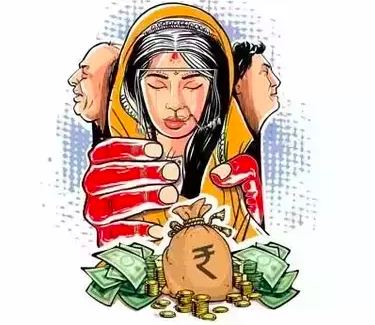By Gatha G Namboothiri


Dowry has been defined as anything with value being given from one party of marriage to the other as a condition for the marriage to take place. The Dowry Prohibition Act passed in 1961 declares that giving or accepting dowry is illegal. It also punishes the people who are involved, who help and facilitate the exchange of dowry.
Want to watch an explainer video on Dowry? It’s provided below:
What is punishable under the dowry law?
1. Giving dowry and taking dowry
Under Section 3 and 4 of the Dowry Prohibition Act, both giving and taking dowry have been made punishable offences. Such actions are punishable by a minimum imprisonment of 5 years and a minimum fine of 15,000 rupees. If you demand dowry, you can be punished with jail time between 6 months and 2 years and/or fine which may go up to Rs. 10,000.
The definition of dowry has been clarified by Courts in India. In S. Gopal Reddy Vs. State of Andhra Pradesh1 (1996), the Supreme Court explained that the definition of ‘dowry’ has to be interpreted flexibly. They also said that if marriage gets cancelled because a party could not give the money or valuable security demanded from them, then this is a case of dowry demand.
There have been different approaches by Courts like in Appasaheb and Anr. Vs. State of Maharashtra2, where the husband’s family asked for money from the bride to meet urgent domestic expenses arising out of financial stringency. This demand was not considered as an illegal act of dowry under the law.
Any agreement for the giving or taking of dowry will not be considered as a valid agreement in the eyes of the law. For example; A’s(bride) family and B’s(groom) family enter into a contract to have the marriage conducted of A and B and in return, A’s family will give a large sum of money and a car as dowry to B. However, under the law, this is not a valid contract and will be treated as if it does not exist. If A’s family does not end up giving the car to B’s family, B cannot take A or her family to Court, for not carrying out the promise under the contract.
2. Facilitating an exchange of dowry
The people who help in the exchange of dowry could also be punished under the law for facilitating this exchange. This could mean friends, family etc who help in the process of exchanging dowry will be punished along with the parties who exchanged the dowry.
3. Offering dowry through advertising and publishing of advertisement of dowry offers
The law punishes people who offer dowry through an advertisement. Printing, publishing or circulating this advertisement is also an offence and the people involved in the same can be punished too with imprisonment of at least six months and/or with fine up to fifteen thousand rupees:
4. Harassment and Violence for Dowry
While making a demand for dowry, any sort of harassment and cruelty by the husband or his family against the wife is criminalized. Both physical and mental harassment caused to a woman would be covered under this. A punishment extending to 3 years and fine has been prescribed as punishment.


Any kind of domestic violence made in the name of dowry demand will also be punishable.
5. Dowry death
Dowry death is the death of a bride that can occur due to harassment and violence arising out of the demand of dowry from the husband and/or his family. The person who has been held guilty for this offence shall receive a minimum punishment of 7 years of imprisonment.
If a woman commits suicide, then the husband and his family can be punished if the suicide was due to harassment she faced for dowry demand. If it can be shown that the woman was subjected to cruelty related to dowry demand before her death, then the Court will assume the death to be a dowry death.
Problems with the Dowry Law
The definition of the word dowry itself has been criticized by scholars for being inadequate or too vague3. As per Section 2 of the Dowry Prohibition Act, dowry has been defined as:
“In this act, ‘dowry’ means any property or valuable security given or agreed to be given either directly or indirectly:
a. by one party to a marriage to the other party to the marriage; or
b. by the parents of either party to a marriage or by any other person, to either party to the marriage or to any other person; at or before or any time after the marriage in connection with the marriage of said parties but does not include dower or mahr in the case of persons to whom the Muslim Personal Law (Shariat) applies.”
Through expressions such as ‘any time after marriage’, there is scope to cover any demand made at any point as long as it has been made ‘in connection with the marriage of the said parties’4.
The law also states that:
“Section 6: Where any dowry is received by any person other than the woman in connection with whose marriage it is given, that person shall transfer it to the woman”.
This section tries to clarify that the dowry given by the bride’s family and collected by anyone is for the benefit of the bride and her heirs. If the bride has deceased, then also the dowry will have to go back to her heirs.
Through this provision, anyone who does not hand over the dowry to the bride or her heirs within a specified time mentioned can be punished with imprisonment and fine. This might seem like a contradiction in the legislation since giving, taking or exchanging dowry is illegal5. However, this section aims to clarify what is to be done in situations where the dowry has been exchanged already, a case has been filed and is ongoing etc6.
Under the Dowry Prohibition (Maintenance of Lists of Presents to the Bride and Bridegroom) Rules, 1985, both the bride and groom are supposed to maintain a list of all the gifts or presents received by them. The law does not criminalize the exchange of ‘presents’ and these will not be considered as dowry since they are given voluntarily.
However, dowry is commonly given under the guise of it being “presents” so many people commonly keep or omit the gifts as per the wishes of the groom. The check done by the law enforcement agencies of the list of presents is also abysmal, thus leading to a continuous rise in dowry related violence.
A continuous rise in dowry-related crimes
Women face issues at every stage while reporting a complaint related to dowry. Many people, to date, continue to believe that such family issues are a private matter that should not be dragged to court. Police might even refuse to file cases of aggrieved women and her family. The delay in our judicial system in handling these cases also contributes to the weak implementation of anti-dowry laws. In 2015, only 34.7% of the accused have been convicted while the rest of the cases continued to be pending. Due to weak implementation, women are further demotivated to approach the law and enforcement agency7.
Since 1961, the Dowry Prohibition Act has been amended twice to make the punishments stronger for more effective implementation. However, according to the data of the National Crime Records Bureau (NCRB), dowry deaths have been consistently on the rise in India. While the number of deaths was 19 per day in 2001, in 2016, it rose to 21 per day.
The nature of dowry-related crimes are continuous in nature and can always make the women feel threatened as long as they live, in their own homes. A study by the UN recently declared that home is the most unsafe place for a woman in the world.8 The nature of such offences is directly linked to the patriarchal nature of the society we live in. Hence, we need to work on social reform through awareness and education along with ensuring implementation of existing laws for a better tomorrow.
_____________________
Gatha N. is member of the Kautilya Society, an initiative of Vidhi Centre for Legal Policy, New Delhi. She is a final year law student at West Bengal National University of Juridical Sciences. Views are personal.
- 1996 SCC Cri 792[↩]
- (2007) 9 SCC 721[↩]
- B. Pramila, A Critique on Dowry Prohibition Act, 1961, Proceedings of the Indian History Congress Vol. 76 pp. 844–850 (2015); Tara S. Kaushik, The Essential Nexus Between Transformative Laws and Culture: The Ineffectiveness of Dowry Prohibition Laws of India, Santa Clara Journal of International Law 1(1) (2003).[↩]
- Ashok Kumar vs State Of Haryana [2010 Cri.L.J. 4402(1)]; State of Andhra Pradesh v. Raj Gopal Asawa [(2004) 4 SCC 470].[↩]
- B. Pramila, A Critique on Dowry Prohibition Act, 1961, Proceedings of the Indian History Congress Vol. 76 pp. 844–850 (2015).[↩]
- Tara S. Kaushik, The Essential Nexus Between Transformative Laws and Culture: The Ineffectiveness of Dowry Prohibition Laws of India, Santa Clara Journal of International Law 1(1) (2003).[↩]
- Parvathi Menon, Dowry Deaths in Bangalore, Frontline 16(17) pp. 64–73 (1999), available at http://www.cwds.ac.in/wp-content/uploads/2016/12/dw_dowry_deaths_in-_bangalore-1.pdf.[↩]
-
Home Is the ‘Most Dangerous Place’ for Women Around the World, New U.N. Study Says, available at https://time.com/5463069/home-most-dangerous-gender-violence-study-un/ (2018); Most dangerous place for women is the home, UN report finds, available at https://www.livemint.com/Politics/xuQddLRcCnaW2drDSKTcUO/Most-dangerous-place-for-women-is-the-home-UN-report-finds.html (2018).[↩]


